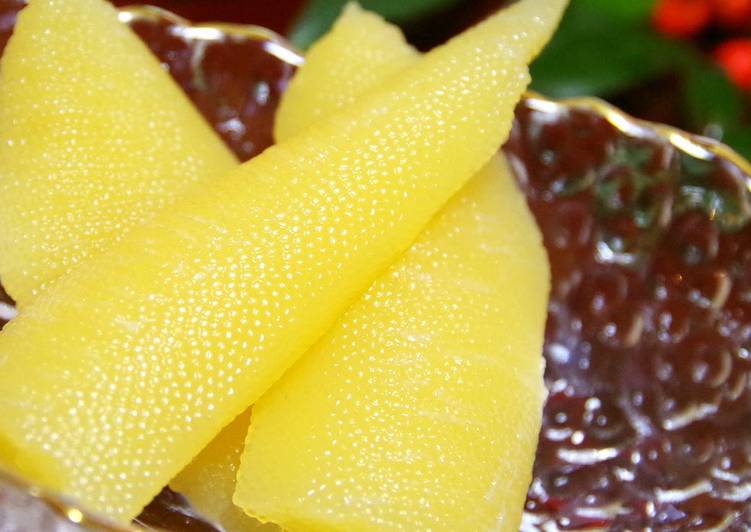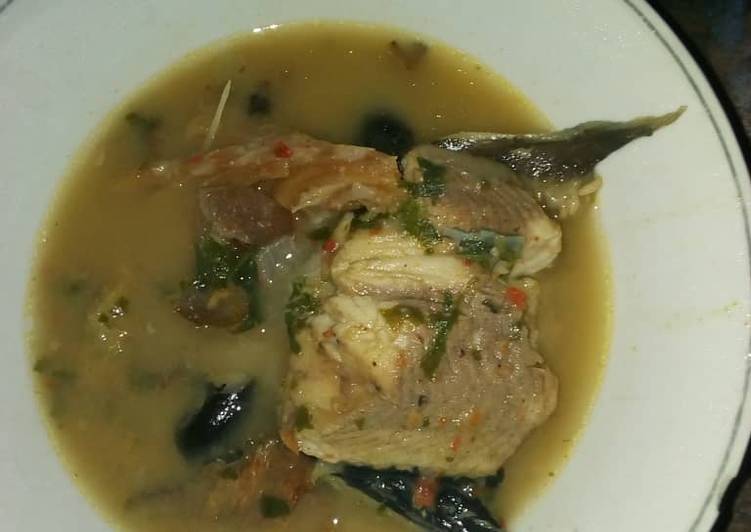
Hello everybody, I hope you’re having an amazing day today. Today, I will show you a way to prepare a distinctive dish, kyoto-style kazunoko with bonito for new year's. It is one of my favorites food recipes. This time, I’m gonna make it a bit tasty. This is gonna smell and look delicious.
Kyoto-style Kazunoko with Bonito for New Year's is one of the most favored of current trending foods on earth. It’s simple, it is quick, it tastes delicious. It is appreciated by millions every day. Kyoto-style Kazunoko with Bonito for New Year's is something which I have loved my whole life. They’re nice and they look wonderful.
Great recipe for Kyoto-style Kazunoko with Bonito for New Year's. Unlike the blackish kazunoko I ate in the Kanto region of Japan that tastes like it's boiled, I wanted to create a beautiful looking kazunoko with a crunchy texture. Dashi stock made only with bonito tends to darken the kazunoko,. Kazunoko is considered a traditional Japanese New Year's dish or "osechi ryori".
To get started with this recipe, we have to first prepare a few ingredients. You can have kyoto-style kazunoko with bonito for new year's using 8 ingredients and 6 steps. Here is how you can achieve that.
The ingredients needed to make Kyoto-style Kazunoko with Bonito for New Year's:
- Prepare 10 Kazunoko (salted herring roe)
- Get 1 Bonito flakes (for garnishing)
- Make ready Marinade
- Take 180 ml Dashi stock (blend of kombu and bonito)
- Make ready 180 ml Sake
- Get 1 tbsp Usukuchi soy sauce
- Make ready 1 tbsp Mirin
- Take 1 pinch Salt
Kazunoko is salted herring roe that has been marinated in seasoned Dashi. My favorite osechi ryori, or Japanese New Year's dish is kazunoko. It's caviar made of herring roe, simply seasoned with dashi konbu (seasoned seaweed), katsuo dashi (bonito broth) and shoyu (soy sauce). Kazunoko is typically found in Japanese supermarkets only at the end of the year, which is quite unfortunate because I wouldn't mind eating this year round.
Steps to make Kyoto-style Kazunoko with Bonito for New Year's:
- Soak the kazunoko for 2 hours in a bowl of water with a small amount of salt, replace with water, then soak for 2 more hours to remove excess salt.
- When the salt has been reduced to a subtle amount, carefully remove the white membrane on the surface of the kazunoko with the pad of your thumb. The kazunoko on the left shows what it should look like after it is removed.
- Put the sake into a pot, then heat to evaporate the alcohol. Add the rest of the marinade ingredients, bring to a boil, then cool to the touch.
- Add the kazunoko from Step 2 to the marinade, then allow to soak for 1/2 a day, then it's done. If you wrap them tightly with plastic wrap to press them down into the marinade, you don't need so much of it.
- Sprinkle on some bonito flakes or powdered gold leaf to dress it up.
- I updated a variety of the photos for various recipes. See.
It's caviar made of herring roe, simply seasoned with dashi konbu (seasoned seaweed), katsuo dashi (bonito broth) and shoyu (soy sauce). Kazunoko is typically found in Japanese supermarkets only at the end of the year, which is quite unfortunate because I wouldn't mind eating this year round. Kazunoko is salted herring roe that has been marinated in seasoned Dashi. It is a part of Osechi Ryori, the traditional Japanese New Year feast. There are many kinds of dishes for Osechi Ryori, but Kazunoko is one of the big three celebration dishes, along with Kuromame (sweet black beans) and Tazukuri.
So that’s going to wrap this up for this special food kyoto-style kazunoko with bonito for new year's recipe. Thanks so much for your time. I am sure that you will make this at home. There is gonna be more interesting food at home recipes coming up. Remember to bookmark this page on your browser, and share it to your loved ones, friends and colleague. Thanks again for reading. Go on get cooking!

